Yeovil's Markets
Yeovil's Markets
The markets that ensured Yeovil's prosperity
In order to ensure that taxes were correctly exacted Edward the Elder (King of Wessex, 899-924) forbade the conducting of trades outside of a 'port' (that is, a market town or walled town) or duly appointed place for trading, and without the supervision of a portreeve or other trustworthy person. This, effectively, forced the beginnings of the ‘weekly market’.
The market was a trading institution usually held weekly and vitally important for the financial stability of an early town or borough. At most places in medieval England a market was held on a set day, once a week. The larger towns had several markets on several days a week but it appears that Yeovil, until modern times, had only one weekly market.
Under a charter of King John in 1205 the burgesses of Yeovil gained a market although, of course, the market tolls were taken by the lord, together with the profits from the two fairs confirmed by royal grant in 1421. Later (see below) the Yeovil market was recorded as ‘prescriptive’ that is to say held by custom and not set up by a grant or charter.
A mercatum or
market which was
held by
prescriptive
right was
recorded in
1275-6 as being
held in Yeovil
by Walerand le
Tyeys. In the
same year it was
alleged that
Walerand le
Tyeys had raised
this market at
Yeovil to the
detriment of the
market of the
borough of
Ilchester,
Somerset.
A mercatum or
market which was
held by
prescriptive
right was
recorded 1280 as
being held by
Master Walter
Mautravers,
parson of the
church of
Yeovil. Master
Walter
successfully
claimed that the
market pertained
to the church of
Yeovil and that
he and his
predecessors,
parsons of the
church, had held
the market from
time out of
mind.
On 29 May 1394 an enquiry, recorded in the Calendar of Close Rolls, was ordered to determine whether an illegal market had been held in the town on Saturdays.
In the 1334 Lay Subsidy, Yeovil’s market was reckoned to be worth in excess of £48 per annum, an enormous sum for the time and demonstrates the viability of the Yeovil market and explains why, as a consequence, Yeovil outstripped the other nearby medieval towns of Montacute, Ilchester and Stoford.
The antiquary John Leland, in 1540, called Yeovil a "good market town" and the market was traditionally held in the Borough and adjoining streets.
In 1791 Collinson wrote "The market here is kept on Friday, and is very large for corn, cattle, and pigs; for bacon, cheese, butter, flax, and hemp. In the two last articles there is frequently from 600 to 1,000 (shillings). returned on a market-day. There is a good market-house, seventy feet long, and twenty wide, supported by twenty stone pillars ; and in the middle of it are the remains of an ancient cross. There are also several rows of shambles. "
Also in the eighteenth century the Borough contained two buildings, the Shambles used by butcher's and sometimes called the Butcher's Shambles, and the Market House for the benefit of other market traders. Later, buildings were constructed behind the Town Hall in High Street that included a meat market, cheese market and corn exchange. Indeed the open frontage at ground floor level of the Town Hall itself was given over to market stall traders (although this was later converted to shops) and the 1886 Ordnance Survey labels the building as ‘Town Hall and Market House’, the Shambles and Market House in the Borough having been demolished in 1849.
In 1856 Vickery wrote in his ‘Sketch of Yeovil’ that “the Cattle Market had, from time immemorial, been held in the streets, in the centre of the town. The market day is Friday, every alternate Friday being what is called ‘The Great Market’. Corn, cattle, butter, cheese, hemp and flax, are also sold in great quantities…. In May, 1856, the cattle market was removed from the streets, the Corporation having fitted up what is called the ‘Fair Field’ and which is the property of the town, as the future market…. The field, as at present proposed to be fitted up, will contain about 436 bullocks and 520 sheep; North Lane about 120 bullocks more. The highest number of bullocks at market during the last four years was 460, the average 300; the greatest number of sheep being 500, the average 300.”
In the latter part of the 20th century the market moved to the Petters Way car park adjoining South Street and, more recently, is now held in the pedestrianised Lower Middle Street.
gallery
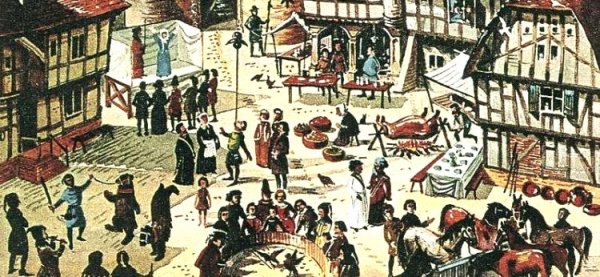
An illustration of a medieval market. Shame you don't see so many dancing bears these days.
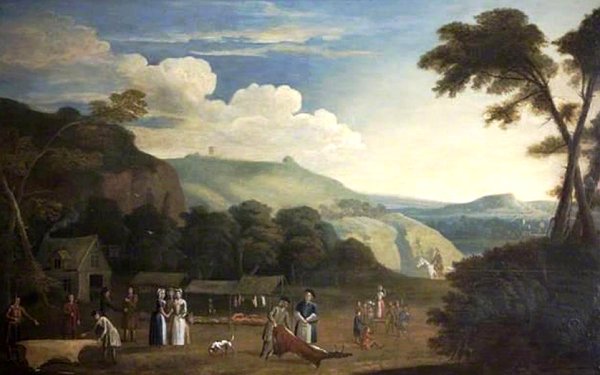
This painting, oil on wood and 87cm x 146.5cm by the British (Naïve) School, is entitled "Old Yeovil Skin Market". It was donated to Yeovil Museum in 1924 and is now at the Community Heritage Centre. The landscape is, of course, somewhat fanciful although the hill at centre is most likely Summerhouse Hill surmounted by the Summer House (built in the 1740s).
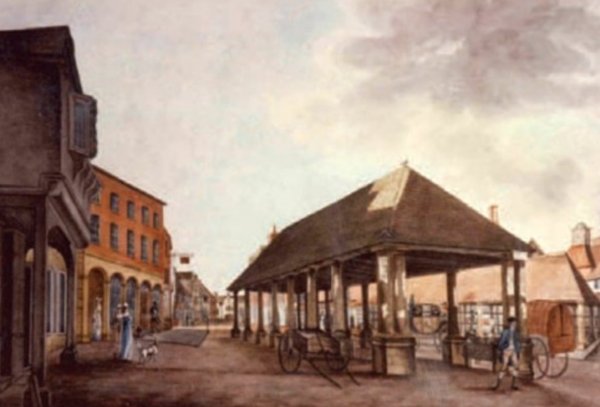
A painting made in 1810 of the Borough looking towards High Street which runs to the distance at left. The building at centre was the Market House, built in 1740, and behind it to the right was the butcher's Shambles, built in 1803.
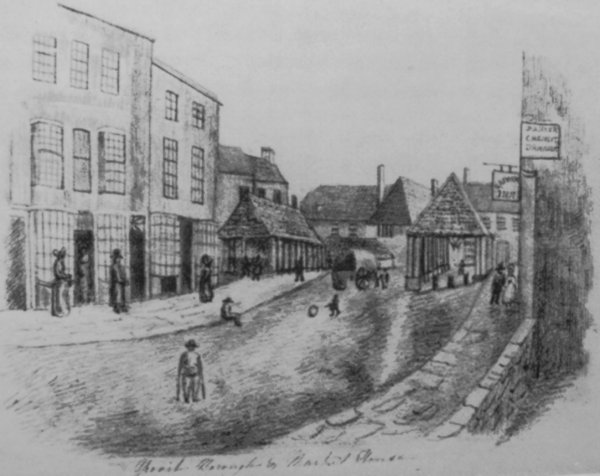
This sketch, probably made around 1830, shows the Borough seen from High Street - roughly the view seen today from the north end of King George Street. The Shambles is to the left and the Market House is to the right.
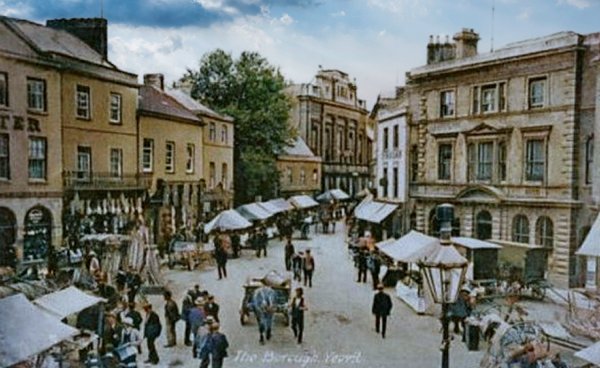
From my
collection. This
colourised photograph
features in my
book 'Secret Yeovil'.
A postcard of about 1905 (this one was posted in 1911) showing the Town Hall beyond the weekly market in the Borough.
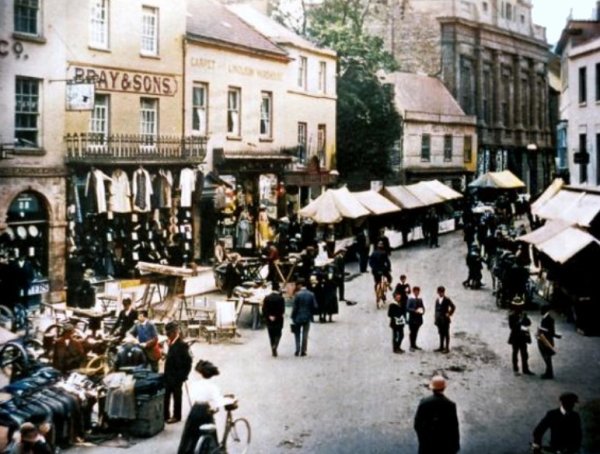
The weekly market in the Borough in a colourised photographed of about 1912. Notice that, although the signage of the three shops at left have changed, the stalls in High Street look identical to those in 1905.
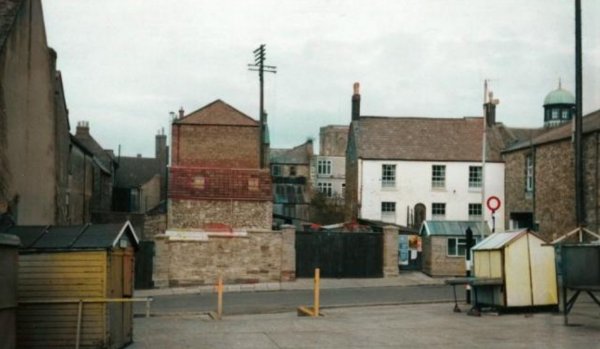
South Street seen from the Petters Way market, now the car park, in a colourised photograph of the 1950s. At extreme left is the end wall of the Three Choughs, the white house right of centre was the market toll collector's house owned by the Corporation and at right is the old Cheese Market, by this time used as the town fire station. The domed turret at for right is on the roof of the municipal offices - there's a good view from there albeit very dusty getting to it through the roof-space of the offices.
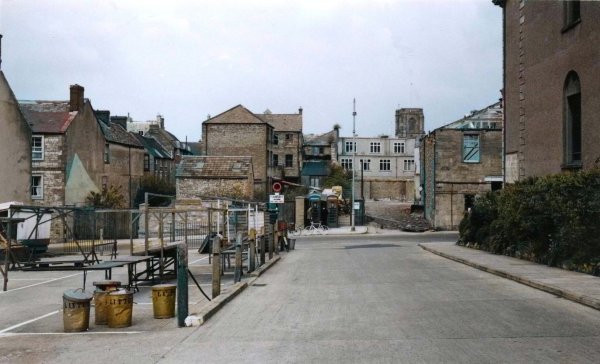
From the Cave
Collection
(colourised),
Courtesy of South Somerset Heritage Collection
Market stalls left in-situ in what is now the Petters Way car park. Photographed in the 1960's from Petters Way looking towards South Street.

Courtesy of
Colin Haine
Looking at the Petters Way market site from South Street in 1985.
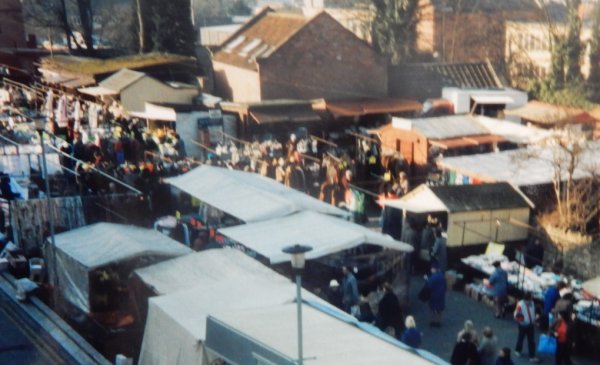
The bustle of the Petters Way Friday market, photographed in the 1990s.

This photo
features in my
book "Now
That's What I
Call Yeovil"
.... and a slightly different shot.
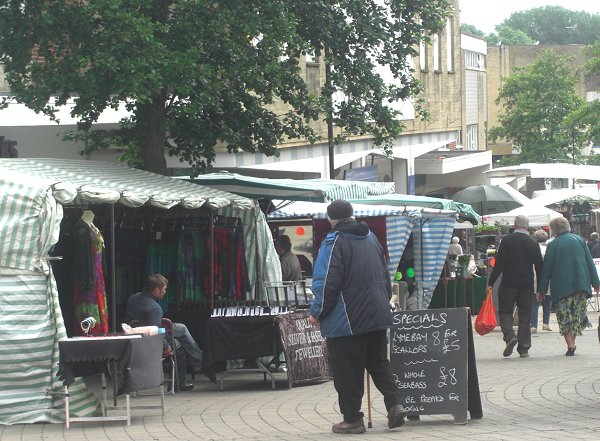
The Friday market, now in Lower Middle Street. Photographed in 2013.